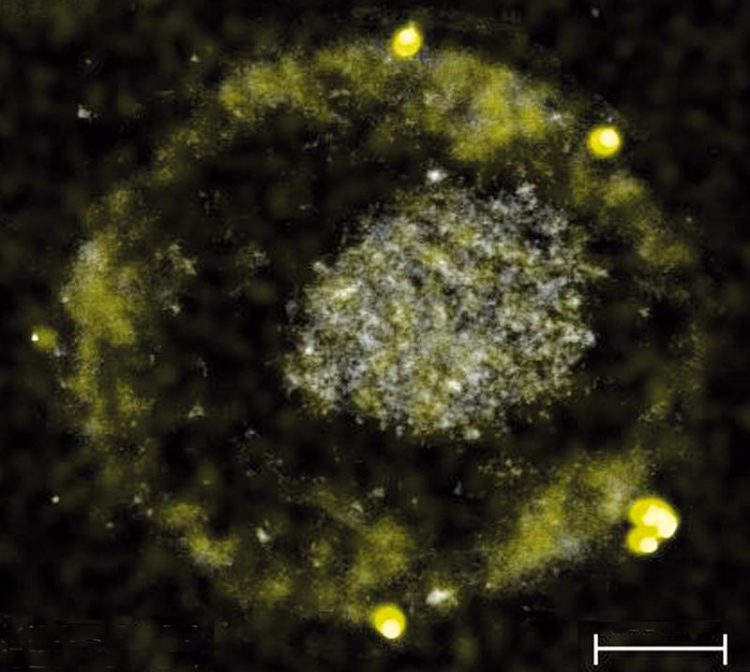These Bacteria produce gold by digesting toxic metals

C. metallidurans can produce small gold nuggets American Society for Microbiology
The rod-shaped bacterium C. metallidurans primarily lives in soils that are enriched with numerous heavy metals. Over time some minerals break down in the soil and release toxic heavy metals and hydrogen into their environment. “Apart from the toxic heavy metals, living conditions in these soils are not bad. There is enough hydrogen to conserve energy and nearly no competition.
If an organism chooses to survive here, it has to find a way to protect itself from these toxic substances,” explains Professor Dietrich H. Nies, a microbiologist at MLU. Together with his Australian counterpart, Professor Frank Reith from the University of Adelaide, he was able to prove in 2009 that C. metallidurans is able to deposit gold biologically. Why it does this and the exact processes that take place remained unknown. Now the researchers have finally been able to solve the mystery.
Gold enters the bacteria the same way as copper. Copper is a vital trace element for C. metallidurans however it is toxic in large quantities. When the copper and gold particles come into contact with the bacteria, a range of chemical processes occur: Copper, which usually occurs in a form that is difficult to be taken up, is converted to a form that is considerably easier for the bacterium to import and thus is able to reach the interior of the cell. The same also happens to the gold compounds.
When too much copper has accumulated inside the bacteria, it is normally pumped out by the enzyme CupA. “However, when gold compounds are also present, the enzyme is supressed and the toxic copper and gold compounds remain inside the cell. Copper and gold combined are actually more toxic than when they appear on their own,” says Dietrich H. Nies.
To solve this problem, the bacteria activate another enzyme – CopA. This enzyme transforms the copper and gold compounds into their originally difficult to absorb forms. “This assures that fewer copper and gold compounds enter the cellular interior. The bacterium is poisoned less and the enzyme that pumps out the copper can dispose of the excess copper unimpeded. Another consequence: the gold compounds that are difficult to absorb transform in the outer area of the cell into harmless gold nuggets only a few nanometres in size,” says Nies.
In nature, C. metallidurans plays a key role in the formation of so-called secondary gold, which emerges following the breakdown of primary, geologically created, ancient gold ores. It transforms the toxic gold particles formed by the weathering process into harmless gold particles, thereby producing gold nuggets.
The study conducted by the joint German-Australian research team provides important insights into the second half of the bio-geochemical gold cycle. Here primary gold metal is transformed by other bacteria into mobile, toxic gold compounds, which is transformed back into secondary metallic gold in the second half of the cycle. Once the entire cycle is understood, gold can also be produced from ores containing only a small percentage of gold without requiring toxic mercury bonds as was previously the case.
About the Publication in “Metallomics”:
Bütof, L., N. Wiesemann, M. Herzberg, M. Altzschner, A. Holleitner, F. Reith and D. H. Nies (2018). “Synergetic gold-copper detoxification at the core of gold biomineralisation in Cupriavidus metallidurans.” Metallomics: in press, doi:10.1039/c7mt00312a
The researchers recently published another study about the synergistic toxicity of copper and gold compounds in C. metallidurans:
Wiesemann, N., L. Bütof, M. Herzberg, G. Hause, L. Berthold, B. Etschmann, J. Brugger, G. Martinéz-Criado, D. Dobritzsch, S. Baginski, F. Reith and D. H. Nies (2017). “Synergistic toxicity of copper and gold compounds in Cupriavidus metallidurans ” Appl Environ Microbiol 83: e01679-17. doi: 10.1128/AEM.01679-17
Media Contact
More Information:
http://www.uni-halle.deAll latest news from the category: Life Sciences and Chemistry
Articles and reports from the Life Sciences and chemistry area deal with applied and basic research into modern biology, chemistry and human medicine.
Valuable information can be found on a range of life sciences fields including bacteriology, biochemistry, bionics, bioinformatics, biophysics, biotechnology, genetics, geobotany, human biology, marine biology, microbiology, molecular biology, cellular biology, zoology, bioinorganic chemistry, microchemistry and environmental chemistry.
Newest articles

Properties of new materials for microchips
… can now be measured well. Reseachers of Delft University of Technology demonstrated measuring performance properties of ultrathin silicon membranes. Making ever smaller and more powerful chips requires new ultrathin…

Floating solar’s potential
… to support sustainable development by addressing climate, water, and energy goals holistically. A new study published this week in Nature Energy raises the potential for floating solar photovoltaics (FPV)…

Skyrmions move at record speeds
… a step towards the computing of the future. An international research team led by scientists from the CNRS1 has discovered that the magnetic nanobubbles2 known as skyrmions can be…





















